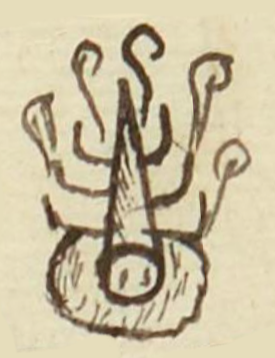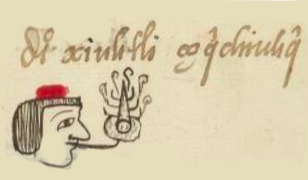Xiuhtli (MH900v)
This black-line drawing of the simplex glyph for the personal name Xiuhtli (“Comet”) is attested here as a man’s name. The glyph shows a descending comet (xiuhtli) with two small concentric circles at the bottom, and two dots or very short lines that are perhaps meant to be two eyes. These are inside the smaller circle. The larger circle, almost a halo around the smaller circle, has some short lines inside it, as does the body of the comet, which comes to a point at the top. Surrounding the comet and coming off the exterior are what look like six legs of an insect and five volutes. The latter could represent smoke.
Stephanie Wood
Some other glyphs of comets also resemble insects, bugs, or snakes, as shown below. They seem animate, probably because they are observed to move across the sky.
Stephanie Wood
dio xiuhtli çoq~chiuhq~
Diego Xiuhtli, zoquichiuhqui
Stephanie Wood
1560
Jeff Haskett-Wood
cometas, colas, volutas, cabezas, ojos, serpientes, nombres de hombres

xiuh(tli), comet, https://nahuatl.wired-humanities.org/content/xiuhtli
Cometa
Stephanie Wood
Matrícula de Huexotzinco, folio 900v, World Digital Library, https://www.loc.gov/resource/gdcwdl.wdl_15282/?sp=873&st=image.
This manuscript is hosted by the Library of Congress and the World Digital Library; used here with the Creative Commons, “Attribution-NonCommercial-ShareAlike 3.0 License” (CC-BY-NC-SAq 3.0).








